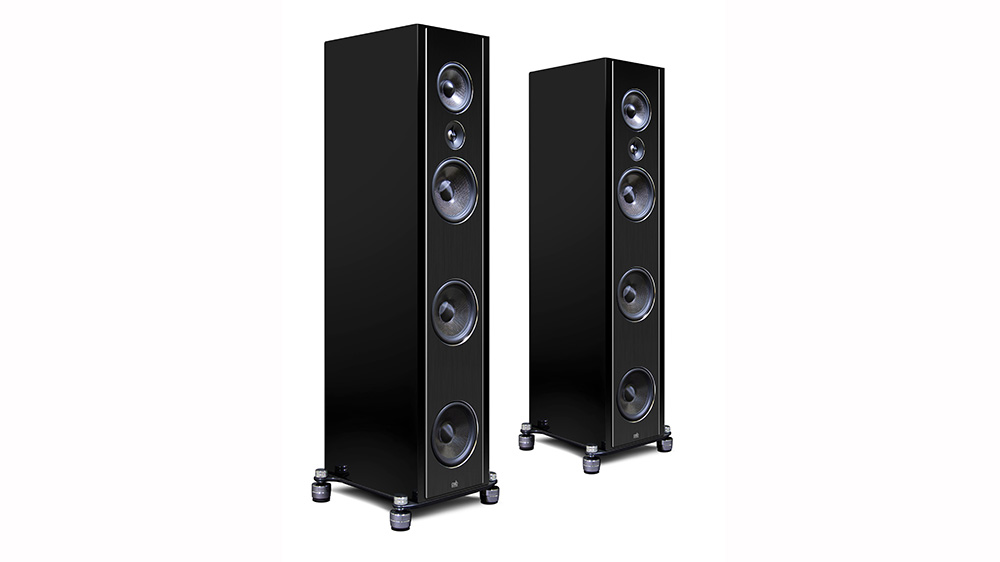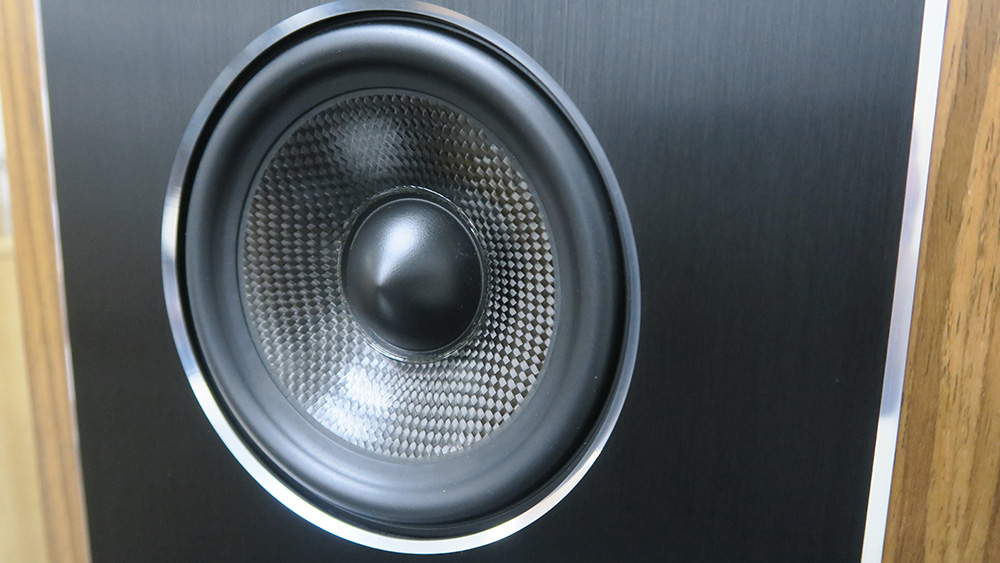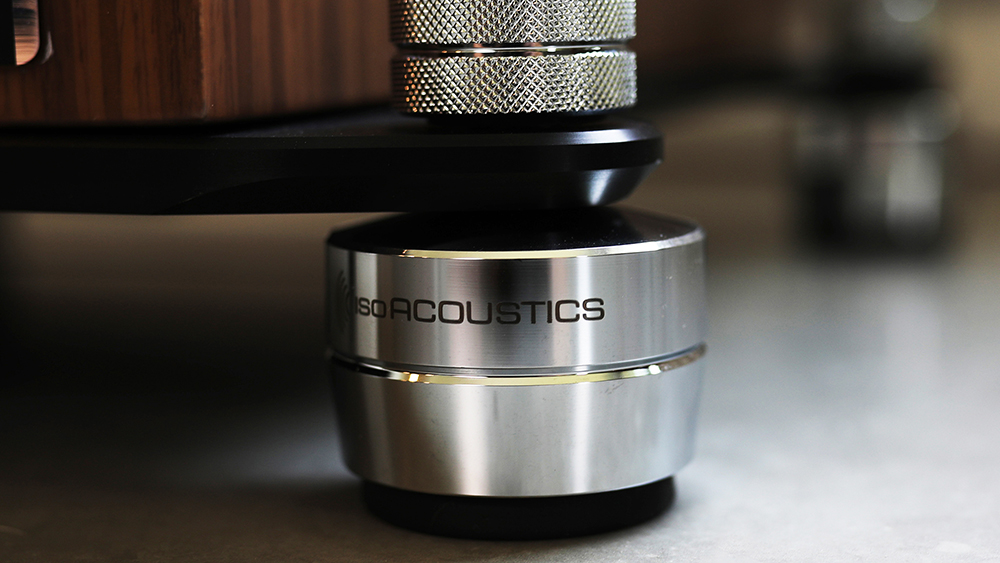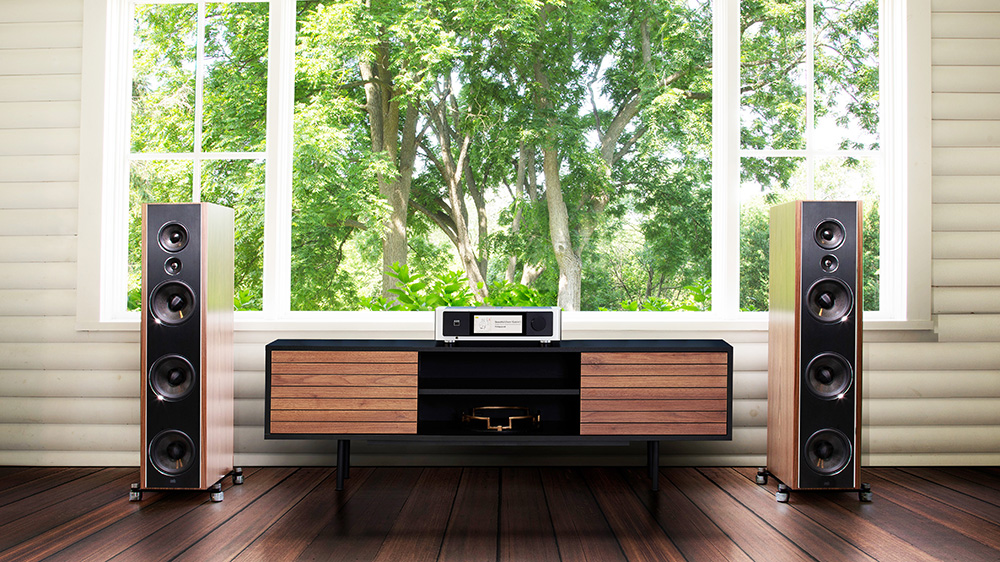What Hi-Fi? Verdict
PSB's flagship Synchronys are among the very best-sounding speakers Australian Hi-Fi magazine has ever come across, irrespective of price
Pros
- +
Superb bass performance
- +
Accurate mids and highs
- +
Overall lovely sound quality
Cons
- -
Imposing size
- -
Veneer finish
Why you can trust What Hi-Fi?

This review and test originally appeared in Australian Hi-Fi magazine, one of What Hi-Fi?’s sister titles from Down Under. Click here for more information about Australian Hi-Fi, including links to buy individual digital editions and details on how best to subscribe.
PSB was founded by famous Canadian loudspeaker designer Paul Barton and his wife Sue (Paul and Sue Barton... get it?). Their company became so successful that the privately owned Canadian Lenbrook Group (which also owns NAD and Bluesound) made the couple an offer for it that they couldn’t refuse – particularly since the group wanted Paul to stay on as lead designer for all PSB products.
Barton is renowned for being a ‘sound quality first, looks second’ designer; an engineer who won’t sacrifice sound quality for fashion – and this philosophy is a little on show with the new Synchrony T800. They’re not exactly small, nor are they exactly sculpted like some modern tower speaker designs. They also have rather blocky-looking outrigger feet at each tower’s base that are, again, not exactly good-looking. In a world where most large and expensive loudspeakers are rather curvaceous, the T800 are decidedly boxy!
So even though the T800 are touted as ‘cost no object’ designs, we suspect that, unlike some speaker manufacturers who shall remain mercifully nameless, Barton was unwilling to spend more money on cabinets than on the drivers and crossover networks built into them.
Build & design
We have to admit that we were initially baffled by the description of the design of the Synchrony T800 as being a ‘transitional’ bass reflex one, so this was one of the first aspects of the speaker we investigated. It turns out that Barton has extended a type of crossover design used in many two-way loudspeakers that sport two bass drivers in combination with a single tweeter, for use in this four-driver, three-way loudspeaker. We can’t recall ever seeing this type of design previously.
But before scrutinising that further, let’s first look at the most important aspect of the Synchrony T800’s design – because it is by far and away the most important: the fact that it’s a true three-way design, sporting three large-cone (203mm diameter) drivers to deliver low frequencies, a single, somewhat smaller-cone driver (133mm) to deliver midrange frequencies, and a single 25mm titanium dome driver to deliver high frequencies.

Design: Transitional 3-way bass reflex
Frequency Response: 21Hz–23kHz ±3dB
LF Cutoff: 20Hz
Crossover: 450Hz (B3), 1.8kHz (LR4)
Sensitivity: 89dB SPL (Anechoic), 91dB SPL (Room)
Nominal Impedance: 4 ohms
Dimensions (hwd): 121 x 38 x 40cm
Weight: 45.4kg
The importance of the three-way design is that it eliminates a serious problem called phase modulation distortion, or PMD, which affects all loudspeakers that do not have a dedicated midrange driver. This distortion occurs whenever a single speaker cone is called upon to reproduce low and midrange frequencies simultaneously, which is what happens in all two-way (and 2.5-way) speaker designs.
Phase modulation distortion is sometimes called ‘Doppler Distortion’ because many people already know about the Doppler effect, which makes the PMD mechanism easier to explain. If a driver is required to produce a single low-frequency sound – at, let’s say, 55Hz – its cone will move forwards and backwards fifty-five times per second and your ear would hear the resulting movement of air as the musical note A1. This pitch is an octave above the lowest ‘A’ on a piano keyboard.
The latest hi-fi, home cinema and tech news, reviews, buying advice and deals, direct to your inbox.
But if that same driver is also asked to produce another musical note – say, middle-C, which has a frequency of 261.63Hz – it would have to move forwards and backwards 261.63 times per second at the same time that it is also moving forwards and backwards 55 times per second. This means the frequency of what should be middle-C will not always be precisely 261.63Hz but actually be shifted up to 55Hz higher or lower (depending on the direction the cone is moving) as a result of having to produce the 55Hz signal simultaneously. Obviously, this introduces considerable distortion into the music! (We don’t want to go into too much detail about PMD in this review, so if you want to know more, you can read a complete explanation (with measurements) at https://sound-au.com/doppler.htm.

Another important thing to note about the T800’s midrange driver is that its construction is exactly the same as that of its three bass drivers, using the same cone material (carbon fibre) and roll surround material (rubber). This means that the sonic ‘signature’ of the midrange driver will be exactly the same as that of the bass drivers. In designs where the construction of the midrange and the bass driver(s) differ, they will produce completely different sonic characters, which is obviously not desirable.
There’s a further aspect of the Synchrony T800’s cone driver construction that is important to note: the roll surrounds that allow the cones to move are all made from rubber. This is exceedingly important for anyone in Australia (or New Zealand) because rubber surrounds are far more durable than the foam ones often used for this purpose. (The high levels of ultraviolet radiation in Australia and New Zealand destroy the foam.)
So let’s get back to what is behind PSB’s use of a ‘transitional’ bass reflex design and how it works...
In most designs that use multiple bass drivers, all the drivers receive the very same signal from the crossover network. Also, in almost all cases, those multiple bass drivers ‘share’ the same space inside the speaker cabinet, and the problem there is that output from the rear of each driver cone will affect the movement of the others, often adversely. Because the drivers must necessarily be in different positions on the baffle, too, each one causes resonances inside the cabinet at different frequencies, which is usually also detrimental to sound quality.
There’s also an issue that occurs in every floorstanding loudspeaker called ‘floor bounce’ where, because the bass driver is close to the floor, a reflection from the floor creates a ‘notch’ or ‘suck-out’ in the sound coming directly from the driver itself. The frequency of this interference depends on the distance between the bass driver and the floor, as well as the distance between the speaker cabinet and the listening position, but you wouldn’t go far wrong to say that it mostly occurs at frequencies between 100Hz and 200Hz.
A final issue affecting designs with multiple bass drivers is that if they’re delivering exactly the same range of frequencies, you will get the same ‘interference’ effects when the signals from the drivers interfere with each other in the air in front of the speakers. In this specific case, the interference can introduce ‘dips’ and ‘bumps’ in the response – dips when the signals cancel; bumps when they reinforce each other.
In the Synchrony T800’s design, PSB has addressed all of these issues! Firstly, each cabinet is partitioned internally so that each of the drivers is in its own unique acoustic space, meaning the output from the rear of one driver cone cannot interfere with any of the other drivers, either directly or because of resonances. Secondly, the different heights of the drivers mean that the effect of floor bounce is spread over a wider range and so has less effect on the sound. Thirdly, interference between the bass drivers is minimised because they do not all operate over the same low-frequency range courtesy of that ‘transitional’ bass reflex design.
In this transitional design, each bass driver is high-pass filtered at a different frequency, so although all three operate at the lowest frequencies, the bottom driver is rolled off earlier than the one above it, and that one is rolled off earlier than the top one, so that, ultimately, each driver progressively operates over a smaller bandwidth. We are not, therefore, surprised that PSB says of the T800’s crossover network: “This is the most advanced amplitude-perfect Linkwitz-Riley 4th order crossover that PSB Speakers has ever utilised, featuring high-voltage poly film capacitors and oxygen-free interconnect wire for complete
driver control.”

Rather unusually, you can access each of the filter sections directly using the six speaker terminals provided on the rear of each tower, which means you can bi-amp or tri-amp the speakers if you want. PSB says the audible effects of doing this “may be subtle, but the benefits include; transients are less likely to cause clipping and/or speaker damage, reduced distortion and the elimination of errors at low frequencies, while also providing better matching between the power amplifier and speaker.”
The terminals come pre-fitted with a curious buss bar system. If you use the buss bars to link the terminals, you can’t use bare wires or small spades at the same time; you have to instead remove the plastic inserts from the clear plastic ‘WBT-look’ speaker terminals and then use banana plugs to make the speaker wire connections. (The terminals will, however, accept bare wire or small spades if the buss bar is removed.)
The separate internal acoustic space for each driver is ported, so each sits in its own bass-reflex environment, though you can block the output from any one (or all) of the ports with port plugs. PSB says of these ports’ usefulness: “Two port covers are supplied with each tower. The port cover can be used to adjust the bass tuning of the Synchrony where room problems at low frequencies (in the 100Hz region) occur. It is well known that the room can dominate the performance of the low frequencies below 200Hz and the added flexibility of a port cover can tweak/improve the performance in problem room setups. We invite the listener to try plugging any one or multiple ports to better integrate the system in their room because any adjustment of the bass balance could be a welcome improvement in a given system setup. Please experiment; it will be worth the effort. It is impossible to predict what type of room or what the system setup will be; therefore we think the flexibility of multiple ports allows the speaker to be integrated better in a wider variety of situations.” So there you go: experiment!
As for the port covers themselves, whereas most manufacturers supply cheap soft foam covers that cost only a few cents each, will deteriorate like foam surrounds and also ‘leak’ sound (because they’re porous), the port covers provided by PSB are made from massively thick rubber with flexible ribbing and fit tightly into the ports – nothing is going to get past these bungs! That leaves only the mystery of why only two port covers are supplied for each tower when each has three bass reflex ports!
As you can see from the images accompanying this review, the Synchrony T800 are supported by an outrigger base-plate design fitted with IsoAcoustic GAIA II feet. These feet are based on the same three-part technology as IsoAcoustic’s award-winning GAIA II isolators. The outrigger design is intended to increase the T800’s stability, but even with the feet the speakers are still a bit ‘tippy’, so be sure to position them somewhere they can’t accidentally be bumped. The 10mm-thick steel plate on one of our speakers was a bit loose, too, so it might be worth using a hex key to ensure the screws haven’t loosened during shipping. (Note that the base plate comes pre-installed; you just have to install the GAIA II feet yourself.)

As for the GAIA isolators themselves, PSB says that: “The isolators provide a high degree of speaker isolation and control while resisting lateral movement and oscillations to maintain accuracy and alignment with the listening position. Internal reflections with the supporting surface are attenuated, resulting in greater sound clarity and openness.” Our only gripe with the GAIA’s design is that it resists lateral movement so effectively that you can’t really manoeuvre the speakers once they’ve been placed in position without potentially damaging the isolators. This isn’t really an issue, it just means that you should establish precisely where the speakers should be positioned in your room, including how they should be angled relative to the listening position, before you install the isolators.
Note that although the T800’s cabinet is available in a Walnut Satin timber veneer finish (over MDF) or a high-gloss black painted finish, the front baffle is covered by a black aluminium sheet which ensures, according to PSB, “maximum rigidity and density.” Magnetic grilles are provided as standard, too.
Sound
It would be remiss of us not to point out that PSB has been getting a ‘leg up’ from the Canadian government for many years, as much of the design and development work for its speakers over the 50 years it has been building them has been undertaken not at PSB but at the National Research Council’s state-of-the-art acoustic laboratories in Ottawa. The NRC is a nationwide organisation of government-funded institutions in Canada, and its acoustic facility was made famous in audio circles by the now-renowned acoustician Dr Floyd E. Toole, whose research data is today used by every loudspeaker company in the world. However, although the development and design all took place in Canada, the T800 are manufactured in China – a fact that, to its credit, PSB makes abundantly clear both on the packaging and multiple times on the cabinets themselves.
Barton was only 23 years old when he started working with Toole, and the two remain firm friends (though Toole no longer works for NRC, or indeed for Harman International where he moved after leaving NRC). “Floyd was and still is my mentor,” says Barton. “Very quickly after we met, we became very good friends – in fact, when I was in Ottawa I would often stay at Floyd and Noreen’s home. So we worked and played together, you could say. Not to mention listened to a lot of music.” You can read more about those times here: tinyurl.com/PSBHistory.
Barton says the biggest factors in determining whether listeners will find the sound of a loudspeaker realistic or not are the linearity and extension of the speaker’s on-axis frequency response and how closely the off-axis frequency response resembles the on-axis one. We didn’t need to look at any graphs at all in order to realise that Barton had aced all of those factors in the Synchrony T800’s design because they sounded fantastically real in our listening room right from the get-go, delivering a powerful, deep and authentic bass response, a totally natural-sounding midrange, and high frequencies that reached out to the stratosphere.
Their set-up was simple, although the cabinets are so large that they’re going to be very visible even in a large room. We found they worked fantastically well when placed very close to a rear wall, a position which will make them less visually intrusive. And we also preferred their bass reproduction – in terms of both timbre and volume level – with the port plugs in the bottom-most ports. We also liked the sound best when both speakers were aimed directly ‘up’ the listening room – we didn’t toe them in at all, though we guess that if you’re sitting closer than we were (four metres), a little angling might be appropriate.

As stated earlier, the bass was powerful, extended and authoritative. You most definitely will not need an external subwoofer if you’re using these in a stereo system, though if you’re lucky enough to have them at the helm of a multi-channel home cinema system, using a sub would make sense, in which case we’d recommend PSB’s own SubSeries 450 DSP sub as being the best acoustic ‘fit’.
It’s pretty hard to go past listening to an orchestra in full flight if you’re testing bass, because the instruments are acoustic and so you know what they sound like, and orchestral percussion, in particular, delivers some of the lowest frequencies the human ear can detect. And if you can add a pipe organ into the mix, so much the better! You will not, then, be surprised that one of the first works we played was Saint-Saëns’ famous Symphony No. 3, often known simply as the ‘Organ Symphony’ and which he dedicated to the memory of Franz Liszt. Whereas many organ aficionados would reach for the version with Charles Munch and the Boston Symphony Orchestra, which has Berj Zamkochian on organ (our musical choice would be Eugene Ormandy and the Philadelphia Orchestra with Michael Murray), the version we listened to featured Jean-Jacques Kantorow and the Orchestre Philharmonique Royal de Liège with Thierry Escaich on organ; we think it has the best sound quality of the three, a quality that has been beautifully captured on SACD by BIS (BIS2470).
Just before the organ is introduced, the atmosphere is breath-quiet, so the plucked strings (cello and bass) and tones of the clarinet and oboe created a tension we can’t recall experiencing previously – one that is released first by the organ’s softly sustained A-flat, then heightened once again by the switch to D-flat major, introducing a ghostly mysterious and haunting dialogue between the organ and the strings that permeate the second movement. Simply stunning, not least because the T800 reveal the lowest organ pedals, which simply aren’t audible through most loudspeakers. Even if you aren’t a classical music fan, we recommend you take ten minutes to audition the closing minutes of this symphony through the Synchrony T800 at the highest volume your dealer will allow. Just make sure you leave your credit card at home before you do!
The human voice is, of course, an essential part of auditioning any loudspeakers because that’s the sound our ears and brains are tuned to be the best at assessing. We started a little low in the frequency range, with the bass/baritone/tenor a capella sound of The Fairfield Four and their great album ‘I Couldn’t Hear Nobody Pray’. Right from the first track, Noah, we could hear that the Synchrony T800 were accurately delivering the sound of the four voices, and then when These Bones chimed in, well, just wow!
Using a female voice to test a little higher in the frequency range, we just had to fire up Joni Mitchell’s ‘Blue’, which she recorded back when she was a mezzo-soprano with a wonderful vibrato, yet was able to drop down to the contralto that she’d stick with in later years. It’s an album we never tire of playing. The PSB Synchrony T800 delivered it as well as we’ve ever heard it, from Mitchell’s voice to her guitar, her piano and her faithful Appalachian dulcimer. And can’t you just tell that it is James Taylor on guitar? The Synchrony T800 make it abundantly clear!

Loudspeakers that can accurately reproduce Saint-Saëns’ Symphony No. 3 at high volume levels will be able to accurately reproduce any type of music at all at any volume, but we found listening to the Synchrony T800 just so pleasurable and exciting that we continued our auditions for much longer than was necessary for us to draw our conclusions. We can, therefore, tell you that if you want to fire up some rock to test the T800 yourself, make sure you listen to Pink Floyd’s ‘The Wall’. In Another Brick In The Wall: Part 1, listen to the incredible detailing – the way it is so easy to hear the children playing in the schoolyard and the atmospherics around the highest frequencies. Then, in The Happiest Days Of Our Lives, the interlude before ABITW: Part 2, the sound of the bass and the drums is just awesome – particularly that of the cymbals, both the crash and the cut-off. When Part 2 kicks off good and proper, that deep bass is again gut-wrenching, but don’t miss how it is so perfectly pitched by the T800. When the organ and lead guitar perform their ‘dual solo’, listen to how the organ is phased and that the guitar is not – a trick made crystal-clear by the PSBs.
Of course, you can’t play any one Floyd album without also playing ‘Dark Side Of The Moon’ as well, so we did, and our admiration for the Synchrony T800 grew even more for it. Listen to the cymbal ride in Breathe (In The Air), the clock sounds in Time and the piano sound and wordless vocal in Great Gig In The Sky. You certainly won’t want to miss the sonic madness of Money, either.
You can evaluate the T800’s extreme high-frequency performance with the synthetic sounds that permeate all of Bjork’s masterpiece ‘Vespertine’, but if you only want to trial one or two tracks then make them Pagan Poetry and Hidden Place (in that order). And if you’d prefer your high frequencies to sound real, we can’t think of a better album for this than John Klemmer’s ‘Touch’, which is full of them, with the added bonus that you get to hear Klemmer’s silky smooth tenor sax and the perfectly paced percussion from John Guerin and Joe Porcaro. Dive straight into the title track for the ultimate high-frequency experience, but move on to Dolphins for its tinkling highs in the left channel that are as high in frequency as anything you will ever need the Synchrony T800 to reproduce.
Verdict
We would rate these new PSB Synchrony T800 loudspeakers as being amongst the very best-sounding we have ever heard, irrespective of price. At the price being asked for them, there are no others we can think of that come even close to approaching their sound quality. They are that rarest of all finds – true high-end audio bargains!
Readers interested in a full technical appraisal of the performance of the PSB Synchrony T800 speakers should continue on to read the LABORATORY TEST REPORT published in the Jan/Feb 2024 issue #534 of Australian Hi-Fi, available in print & digital editions.
- Check out all our Australian reviews from Australian Hi-Fi & Sound+Image magazines
- Latest news on the April 2024 Australian Hi-fi Show
Australian Hi-Fi is one of What Hi-Fi?’s sister titles from Down Under and Australia’s longest-running and most successful hi-fi magazines, having been in continuous publication since 1969. Now edited by What Hi-Fi?'s Becky Roberts, every issue is packed with authoritative reviews of hi-fi equipment ranging from portables to state-of-the-art audiophile systems (and everything in between), information on new product launches, and ‘how-to’ articles to help you get the best quality sound for your home.
Click here for more information about Australian Hi-Fi, including links to buy individual digital editions and details on how best to subscribe.


